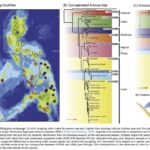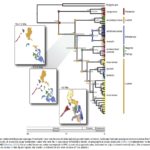Sanguirana arrived in Philippines through over-water dispersal from Palawan

Despite the exceptionally high levels of vertebrate diversity in Southeast Asia, surprisingly little is known about the processes responsible for this occurrence. Recently, an increase in diversity of amphibians has been studied in the Philippines. One genus in particular, Sanguirana, a frog genus endemic to the Philippines, consists of seven species with distinct physical characteristics as well as one or two species that are more closely related. What we are interested in are species within a clade that exhibit a mixture of diversification patterns. Sanguirana is interesting because of its species’ distribution patterns. Of the eight species within this genus, at least four exhibit some degree of overlap in the mountains of Luzon Island, meaning that new species are evolving from a single ancestral species within the same geographic location. To explore this phenomenon, a phylogenetic tree was constructed and it follows the ‘Out-of-Palawan’ biogeographic scenario, which explains that species arrived in the Phillipines from mainland Asia via the large island Palawan. Thus, the genus Sanguirana represents the first amphibian clade whose diversification patterns can be explained by the Palawan Arc Hypothesis.
In order to construct a phylogeny for this genus, individuals from all known species of Sanguirana were collected from various locations in the Philippines. By sequencing nucleotides, the building blocks of DNA from these organisms, information was obtained about the relationships between these species that could then be used to build the phylogenetic tree. The tree supports the idea that the Sanguirana genus can be viewed as a monphyly, or a clade consisting of its ancestral species and all of its descendants, which includes Sanguirana sanguinea, the Palawan Wood Frog. This genus has diversified within the Philippines after an invasion of oceanic islands via the Palawan microcontinent, through 1) instances of overwater dispersal, followed by species radiation, or 2) an increase in diversity or emergence of new species by adapting to a change in the environment, across the archipelago. Today, new species are still being discovered
rown, R.M., Y-C Su, B. Barger, C.D. Siler, M.B. Sanguila, A.C. Diesmos, D.C. Blackburn. 2015. Phylogeny of the island archipelago frog genus Sanguirana: Another endmic Philippine radiation that diversified ‘Out-of-Palawan.’ Molecular Phylogenetics and Evolution. DOI: http://dx.doi.org/10.1016/j.ympev.2015.10.010 pdf
- Figure 1
- Figure 2


